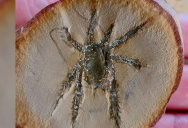Scientists Can’t Quite Figure Out This Fossil Of A 308-Million-Years-Old Arachnid

The cool thing about fossils is that you never know what you’re going to find when you start digging – and even after decades of uncovering the past, there are still mysteries to solve.
Like this 308-year-old fossil, which looks like an 8-legged arachnid.
It’s been named Douglassarachne acanthopoda, and while it does share many characteristics with modern spiders, paleontologists aren’t ready to classify it just yet.
Spiders (and arachnids) have been around for 400 million years, but experts like lead author Paul Selden say D. acanthopoda would have stood out from the rest.
“Douglassarachne acanthopoda comes from the famous Mazon Creek locality in Illinois and is about 308 million years old. This compact arachnid had a body length of about 1.5 centimeters (0.6 inches) and is characterized by its remarkably robust and spiny legs – such that it is quite unlike any other arachnid known, living or extinct.”

The researchers agree that it doesn’t fit into any known order of arachnid.
“The fossil’s very spiny legs are reminiscent of some modern harvestmen, but its body plan is quite different from a harvestman or any other known arachnid group.”
The fossil is old and missing details, like clear mouthparts, that could help narrow it down.
“Whatever its evolutionary affinities, these spiny arachnids appear to come from a time when arachnids were experimenting with a range of different body plans. Some of these later became extinct, perhaps during the so-called ‘Carboniferous Rainforest Collapse,’ a time shortly after the age of Mazon Creek when the coal forests began to fragment and die off. Of perhaps these strange arachnids clung on until the end Permian mass extinction.”

Still, they had to put it somewhere to come up with a name.
“The genus name Douglassarachne acknowledges the Douglass family, who kindly donated the specimen to the Field Museum of Natural History in Chicago for scientific study once it became apparent that it represented an undescribed species. Then, acanthopoda refers to the unique and characteristic spiny legs of the animal.”
As ubiquitous as spiders are today, back then, things were different, and they were fairly rare.
This fossil is exciting, as scientists believe it could lead to more knowledge about prehistoric arachnids as a whole.
If you thought that was interesting, you might like to read about the mysterious “pyramids” discovered in Antarctica. What are they?

Sign up to get our BEST stories of the week straight to your inbox.




